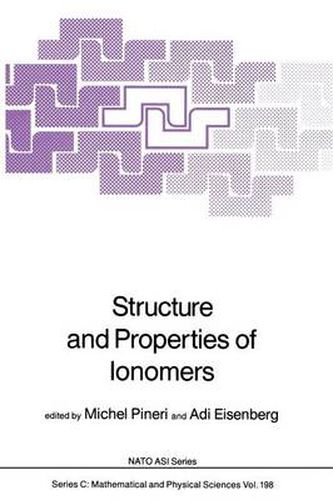Readings Newsletter
Become a Readings Member to make your shopping experience even easier.
Sign in or sign up for free!
You’re not far away from qualifying for FREE standard shipping within Australia
You’ve qualified for FREE standard shipping within Australia
The cart is loading…






This title is printed to order. This book may have been self-published. If so, we cannot guarantee the quality of the content. In the main most books will have gone through the editing process however some may not. We therefore suggest that you be aware of this before ordering this book. If in doubt check either the author or publisher’s details as we are unable to accept any returns unless they are faulty. Please contact us if you have any questions.
Ionomers, that is polymers containing a low concentration of charged units along the chain, have been the subject of increasing interest during the past twenty years. The presence of ionic groups in the poly mer changes some of its properties dramatically. Increases in the modu lus and the viscosity of several orders of magnitude have been observed, and changes in the glass transition of hundreds of degrees are possible. In addition, diffusion coefficients can be modified drastically. These changes are due primarily to the presence of reversible ionic cross links in these materials. Because of the low dielectric constant of most organic polymers, the ions or ionic dipoles tend to aggregate ; this aggregation process, however, is limited, because the ionic groups are covalently bonded to the organic chain. Host of the fundamental research done on these materials has been devoted to a determination of the extent of association, the structure of the aggregates, the limi ting factors, and the correlations between molecular and supermolecular structure and the resul ting properties.
$9.00 standard shipping within Australia
FREE standard shipping within Australia for orders over $100.00
Express & International shipping calculated at checkout
This title is printed to order. This book may have been self-published. If so, we cannot guarantee the quality of the content. In the main most books will have gone through the editing process however some may not. We therefore suggest that you be aware of this before ordering this book. If in doubt check either the author or publisher’s details as we are unable to accept any returns unless they are faulty. Please contact us if you have any questions.
Ionomers, that is polymers containing a low concentration of charged units along the chain, have been the subject of increasing interest during the past twenty years. The presence of ionic groups in the poly mer changes some of its properties dramatically. Increases in the modu lus and the viscosity of several orders of magnitude have been observed, and changes in the glass transition of hundreds of degrees are possible. In addition, diffusion coefficients can be modified drastically. These changes are due primarily to the presence of reversible ionic cross links in these materials. Because of the low dielectric constant of most organic polymers, the ions or ionic dipoles tend to aggregate ; this aggregation process, however, is limited, because the ionic groups are covalently bonded to the organic chain. Host of the fundamental research done on these materials has been devoted to a determination of the extent of association, the structure of the aggregates, the limi ting factors, and the correlations between molecular and supermolecular structure and the resul ting properties.